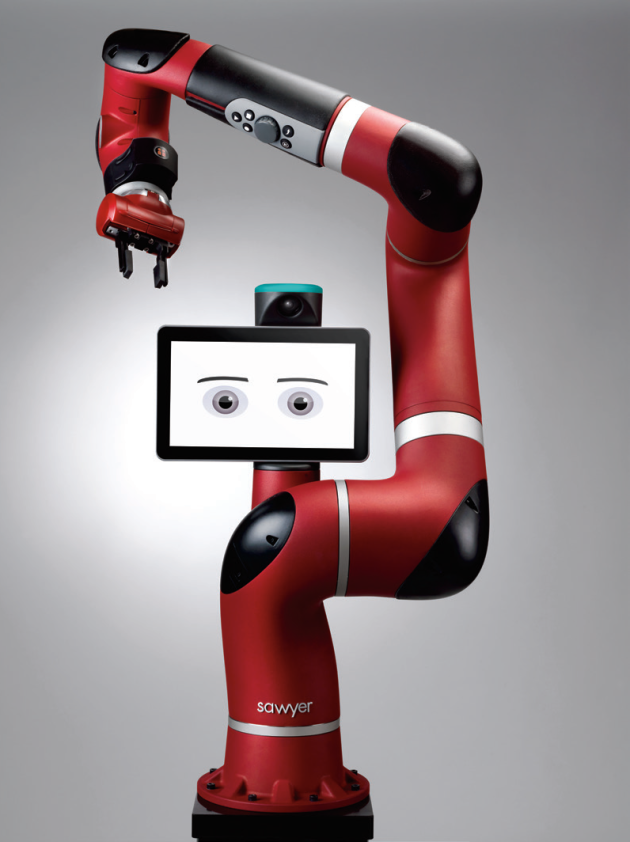Whenever people hear about automation or manufacturing technology, they always respond with “robots?”. Reading mainstream media where writers discuss manufacturing without a clue, they also seem fixated on robots. And most all of this ranges from partial information to misinformation. I seldom write about robotics because the typical SCARA or six-axis robots are still doing the same things they’ve always done—pick-and-place, welding, painting, material handling. They are better, faster, more connected, and in different industries, but in the end it’s still the same thing.
That is why I’m a fan of Rethink Robotics. These engineers are out there trying new paradigms and applications. Here is a recent release that I think bears watching. This news is especially relevant in the context of the visit I made last week to Oakland University and conversations with some students.

Rethink Robotics unveiled the Sawyer Software Development Kit (SDK), a software upgrade designed for researchers and students to build and test programs on the Sawyer robot. With a wide range of uses for university research teams and corporate R&D laboratories around the world, Sawyer SDK offers further compatibility with ROS and state-of-art Open Source robotics tools, as well as an affordable solution to increase access to advanced robotics in the classroom.
Sawyer SDK includes several advanced features that allow users to visualize and control how the robot interacts with its environment. Sawyer SDK now integrates with the popular Gazebo Simulator, which creates a simulated world that will visualize the robot and its contact with the environment, allowing researchers to run and test code in the simulation before running it on the robot. Sawyer’s Gazebo integration is completely open source, allowing students to run simulations from their individual laptops without a robot until they’re ready to test the code in real time. This approach allows professors to provide students with access to the industry-leading collaborative robots.
In addition to the Gazebo integration, Sawyer SDK includes a new motion interface that allows researchers to program the robot in Cartesian space. This development lowers the barriers for motion planning for programmers without a full robotics background. The new release also allows researchers to leverage new impedance and force control. Sawyer SDK also includes support for ClickSmart, the family of gripper kits that Rethink announced in 2017 to create a fully integrated robotic solution.
“Rethink’s robots are used in the world’s leading research institutions, which provides us with a wealth of feedback on what our research customers really want,” said Scott Eckert, president and CEO, Rethink Robotics. “As we have with all of our SDK releases, we’re continuing to set the standard in research with industry-leading features that allow universities and corporate labs to push the field of robotics forward and publish their research faster.”
Sawyer SDK is being piloted in robotics programs at multiple universities, including Stanford University, University of California at Berkeley, Georgia Institute of Technology and Northwestern University. Stanford’s Vision and Learning Lab works on endowing robots with diverse skills for both industrial and day-to-day personal robotics applications.
“Robotics is a field that combines technological and engineering skills with creativity, and the inventiveness our students have shown so far with the robots has been astounding,” said Dr. Animesh Garg, postdoctoral researcher in the Stanford University department of computer science. Animesh and his team of researchers have put Sawyer to use executing tasks directly from virtual reality (VR) input using automatic decomposition in simpler activities. Sawyer is also used for ongoing work in learning to use simple tools, such as hammers and screwdrivers.
Stanford University’s Experimental Robotics class allows students to think beyond day-to-day industrial tasks. They’ve trained Sawyer to draw, and track moving targets and hovering drones. Rethink’s Sawyer has enabled faster learning curves for researchers and students alike, making it easier than ever with the Sawyer SDK release.
The SDK will be available on all Sawyer robots, allowing access to both the Intera manufacturing software and the SDK software, starting in March 2018.





